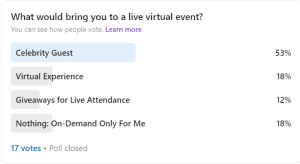What is Virtual Fatigue?
Even though the virtual world seems to be more productive, it comes with unexpected side effects, Video Calls, and Webinar Fatigue. Video conferencing drains attendees and could ultimately result in lower webinar attendance or lost productivity in work-from-home environments.
It may not seem strenuous to sit and discuss over a video, however, your body may disagree. These tips will help attendees to stay more engaged and motivated while helping virtual event planners orchestrate a webinar with most promise for success.
Causes of Virtual Fatigue: Moving, Mirroring, and Maneuvering
Stanford researchers found multiple causes of virtual fatigue and how to combat them.
A cause of this fatigue is the overall decrease in mobility. Workers are no longer moving from one conference room to another, heading back to their desk in between meetings, or strolling to the breakroom to step away from work. There are also fewer casual conversations between coworkers by logging into meetings right at the start time.
Missing out on the small talk before a meeting decreases human interaction. The brain can no longer take a break from work and shift focus for bits throughout the day. During video calls, it is easy to become rigid while on camera. Focusing on not being a distraction or perceived as rude by averting eye contact, which is also draining.
Using video typically allows users to see themselves too, which is abnormal compared to a typical day. Watching themselves talk, question, and discuss causes pressure and increased personal criticism. Workers are more concerned about the perception of themselves versus the reality of how they act and feel, draining mental capacities. The mirrored image can be dissatisfying, adding additional negative emotions.
Another cause of virtual fatigue is up close and personal interaction. Not only is eye contact increased in the video, but it is also much closer to each other than it would be in person. This invasion sends stress signals to your body about someone being in your bubble.
Improve Attendance and Engagement for your Webinars
With virtual communication being seemingly more exhausting, there are ways to avoid this decline in engagement. According to Click Meeting, webinar frequency increased five times from 2019 to 2020. The average attendance rate is 40-50% of registrants. With 57% of marketers running up to 50 webinars a year, and the average attendee only attending one webinar a week, it is tough to design a webinar worth someone’s time.
CTG put together a LinkedIn poll to determine what brings people to webinars, and we found that a celebrity appearance for attendees are the best motivational factors to use to get people to attend. 53% of our voters chose a celebrity guest as the top thing to bring them to a live virtual event. Other choices included in our survey were virtual experiences, gift incentives, or on-demand sessions only, but these were not as popular when compared to a celebrity guest.
It’s no surprise a Celebrity Guest is the top pick, but each of these all come with their own level of expenses. A celebrity appearance could run you anywhere from $5,000 to over $10,000 depending on their experience and title. If a celebrity guest is out of the budget, a virtual experience or ensuring the sessions can be accessed on demand could also bring in a large attendees.
According to 99 Firms, promoting the event using email is rated as the most effective webinar promotion tool. Sending a reminder email on the day of the event increases attendance by 20%. Another channel which is received well is social media. Updating your followers on the highlights of the event can increase interest without much overhead.
Host the webinar on a Thursday. Mondays can be too busy, Fridays are full of distractions. Thursdays are the best days to host webinars with 35% of attendees signing up 1 to 7 days before the event. Keep this in mind when planning your email campaign.
Once they attend, 92% of attendees expect a live Q&A session at the end of the webinar. Live Q&As are popular because they offer a fun way for attendees to interact with the presenter and get the answers they are looking for.
Implement a way for the attendees to interact. Whether this be via chat, or having discussions outside of the session while still on the webinar platform. This increases the networking value of the event, and also a social interaction factor that would be included in an in-person event.
Not only is the live interaction important, on-demand viewing adds additional value. Allowing registrants to watch the sessions if they are unable to attend live will increase the reach of the webinar. This is also important for attendees to be able to go back and take notes, listen to the parts that resonate with them most, or simply take breaks without missing information.
How to Combat Virtual Fatigue as a Company
Video has been everything for companies during and post-pandemic, but does it have to be? A company can promote mobile-friendly meetings and webinars. Encouraging employees to interact at a level they feel comfortable with, not always at a desk staying 100% engaged.
A call allows attendees to feel more comfortable fidgeting, moving, or simply not monitoring their every movement. Encouraging video breaks and movement during meetings can ease the subconscious upkeep of professional mannerisms.
How to Combat Virtual Fatigue Personally
Being aware is half the battle of minimizing its effect on personal wellbeing. Minimizing the personal video image will ease the unnaturalness of looking in a mirror for hours daily.
Consider moving the camera position or changing from sitting to standing throughout video calls to increase mobility. Walking or moving can help stimulate the brain while remaining engaged in the meeting and without being distracting.
Give the brain a break from the intimate virtual interaction by turning away from the computer screen altogether. Not only does this take your mirrored image away, but it provides a break from the up-close gestures and reactions of other attendees.
Is Our Future Virtual?
According to Forbes, by 2025, an estimated 70% of the workforce will spend at least five days a month working remotely. Virtual fatigue is not going anywhere. Virtual work and events have proven to be a realistic solution and is preferred by many in the workforce.
By becoming aware of some virtual repercussions, workers can stay energized and healthy while working remotely. CTG has learned to keep this in mind while planning webinars to improve attendance and engagement.
We took what we know about in-person events and applied it to virtual. This means keeping attendees engaged and encouraging incentives to promote attendance. We have experience analyzing your current webinar process, supporting your organization with projects to plan the event, and monitoring the progress before and after the event.


